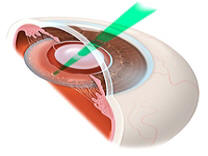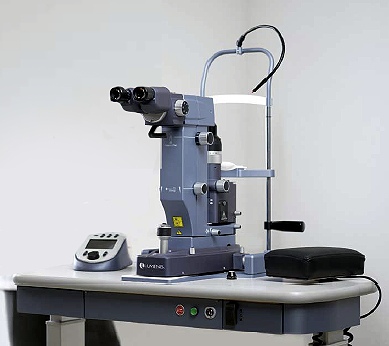|
|
YAG LASER
POSTERIOR CAPSULOTOMY
|
|
 |
|
In Yag Laser Posterior
Capsulotomy, painless laser light is used
improve your vision by opening a cloudy thin
membrane that develops behind your lens
implant months or years after cataract
surgery. |
|
In cataract surgery, a
cloudy lens is removed and replaced with a clear
artificial lens implant. A cataract is a little like a
grape – it has a cloudy meat and a clear, thin skin.
During routine cataract surgery, the cloudy meat is
removed and the back side of the clear, thin skin is
left behind.
That thin back skin of the cataract is called the
“posterior capsule” and it helps to support the lens
implant, initially. The posterior capsule starts out
clear, like plastic-wrap, so you can see through it
without problems.
But, in everybody who has cataract surgery, that back
thin skin, or posterior capsule, gradually turns cloudy,
like wax-paper, over time. It can take anywhere from a
few weeks to a few years for the posterior capsule to
turn cloudy enough to interfere noticeably with clear
vision. The average time is about two years. |
|
| |
| When decreased vision from a cloudy posterior
capsule, (also called a “secondary membrane”) becomes bothersome,
the central portion of the cloudy capsule can be removed with a
quick, painless laser light treatment known as a “Yag laser
posterior capsulotomy.” The procedure usually takes less than a
minute to complete. First, your eye is dilated, and then numbed with
a drop of anesthetic. |
| |
 |
Then, you are seated at the
laser machine, which looks about the same as the
examining microscope that is used in the office. The
doctor focuses the laser light precisely on the cloudy
membrane and delivers the treatment in pulses about
1/10th of a second long. The laser light bursts a hole
in the center of the cloudy membrane that you can see
through, without significantly affecting any other
structures inside the eye. There is no pain at all. All
you experience is flashing of the laser light and a
clicking noise. There is no operating room, no
anesthesiologist, no IV, no laying down, no undressing,
and no pain! |
|
| |
| Immediately after the procedure, you will probably
experience moderately blurred vision and small floating spots. Both
can last up to a few hours. The vision is usually improved by the
next day. There is no restriction of your activities, though you
should have someone with you to drive you home from the procedure,
since your vision will be a little blurred, temporarily. |
| |
| The Yag laser posterior capsulotomy is considered
very safe and highly effective. As with any procedure, there are
risks, but complications are very rare. Details of the advantages
and risks of the procedure are thoroughly reviewed with you, in
advance. |
| |
|
Secondary membranes do not grow back. After a
successful Yag laser posterior capsulotomy, the
procedure should not ever need to be repeated. The
Yag laser has other applications in ophthalmology.
For example, it is sometimes used to create a bypass
channel in the colored part of the eye, or iris, in
people who have a risk of aspecialtype of
glaucoma called “narrow angle glaucoma.”
But the most common use of the Yag laser, by far,
is for the treatment of secondary membranes after cataract surgery.
|
|
 |
|
|
| |
| |
|